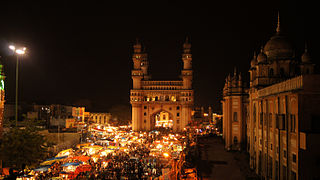
The Charminar is a monument located in Hyderabad, Telangana, India. Constructed in 1591, the landmark is a symbol of Hyderabad and officially incorporated in the emblem of Telangana. The Charminar's long history includes the existence of a mosque on its top floor for more than 425 years. While both historically and religiously significant, it is also known for its popular and busy local markets surrounding the structure, and has become one of the most frequented tourist attractions in Hyderabad. Charminar is also a site of numerous festival celebrations, such as Eid-ul-adha and Eid al-Fitr, as it is adjacent to the city's main mosque, the Makkah Masjid.

The Salar Jung Museum is an art museum located at Dar-ul-Shifa, on the southern bank of the Musi River in the city of Hyderabad, Telangana, India. It is one of the notable National Museums of India. Originally a private art collection of the Salar Jung family, it was endowed to the nation after the death of Salar Jung III. It was inaugurated on 16 December 1951.

Asaf Jah VI, also known as Sir Mir Mahboob Ali Khan Siddiqi Bayafandi, was the ninth Nizam of Hyderabad. He ruled Hyderabad State, one of the princely states of India, between 1869 and 1911.

The Hyderabad Race Club is a thoroughbred racing association and the race track is at Malakpet, Hyderabad, Telangana, India. This race course is considered one of the top racecourses in India and was inaugurated by the 6th Nizam Mahbub Ali Khan.

King Kothi Palace or Nazri Bagh Palace is a royal palace in Hyderabad, Telangana, India. It was the palace where the erstwhile ruler of Hyderabad State, Sir Mir Osman Ali Khan, The Seventh Nizam, lived. it was a palace bought by his father Mahboob Ali Pasha, who had a penchant for buying ostentatious homes.

Mahbub Mansion, also spelt Mahboob Mansion is a palace, named after Mir Mahbub Ali Khan, Asaf Jah VI, the sixth Nizam, who loved visiting here occasionally, though his permanent residence was the Purani Haveli. It is located in the area Malakpet of Hyderabad.

His Excellency Amir e Paigah Basheerd-Ud-daula Azam-Ul-Umra Amir-e-Akbar Nawab Sir Muhammad Mazharuddin Khan Bahadur Rifa’at Jang, commonly known as Sir Asman Jah or Nawab Sir Asman Jah Bahadur, Asman Jah was one of those fortunate individuals to whom it has been given by fate to write their names large in the annals of their country, he was an Indian noble and member of the Great Paigah Family who served as Prime Minister of Hyderabad from 1887 to 1894. As the grandson of the premier noble Fakhr Uddin Khan Amir e Kabir Shams-ul-Umra I and of a princess of the blood, his social position was a great one; but the personal qualities he possessed, inherited largely from his grandfather, were unquestionably the means of bringing him to the front. Singularly gifted by nature as far as the outward man was concerned and excelling in all manly pursuits, he easily took the lead among his peers. But it was his mental and moral equipment which attracted the notice of his royal master while yet the young noble was in early manhood. Such was the promise he showed that His Highness the Afzal-ud-Daulah gave him his daughter in marriage and bestowed on him the highest distinction in his gift, the title of Jah.in 1869, Asman Jah entered on his public career as Minister of Justice. A little later on, while still retaining the portfolio of Justice, he acted as Prime Minister and co-regent. Later still he became a Member of the Council of Regency, and finally in 1887 he was appointed Prime Minister and continued to hold the office till 1893. In this connection it may be noted that throughout his long official career, Sir Asman Jah refused to take any salary while willing to take office he steadily persisted im refusing the emoluments of office. Elis regime as Premier was marked by several reforms, notably the advance made in education, the extension of medical aid by the State, especially aid to women, and the establishment of a permanent Board of Irrigation and city water supply, which has since been of excellent service to the State, Asman Jah was still in London when he got the news of his having been-appointed Prime Minister and one of the first to congratulate him on his appointment was his late Majesty King Edward VIL, then Prince of Wales, Asman Jah built several architectures throughout the city like Asman Garh Palace, Basheer Bagh Palace, saroonagar palace and Mahboob Chowk Clock Tower. Just before he was appointed to the premiership he was deputed by His Highness the late Nizam, Mahboob Ali Khan, to proceed in 1887 to London as his representative at the Golden Jubilee of Her late Majesty Queen Victoria. While in England he won golden opinions by the tact, savoir faire and high breeding he displayed His handsome presence, imposing address and polished manners impressed all classes of English Society and he became a great favourite in court circles. Indeed, the late Nizam could not have had a more dignified or worthier representative.
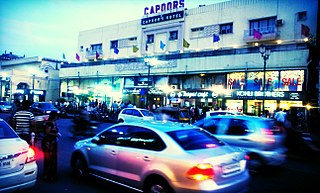
Hazratganj, is the downtown and main shopping hub of Lucknow, the capital and largest city of the Indian state of Uttar Pradesh. In addition to bazaars, it also contains shopping complexes, restaurants, hotels, theatres, cafés and many offices.

Lal Chowk is a city square in Srinagar, in the Indian union territory of Jammu and Kashmir.
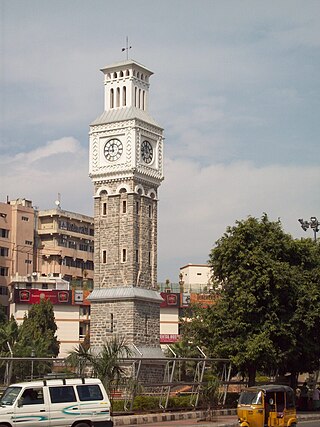
Secunderabad Clock Tower is a clock tower located in the Secunderabad region of Hyderabad, India. Constructed in 1860 on 10 acres (4.0 ha) of land, the structure was inaugurated on 1 February 1897.

The Old City of Hyderabad is a walled city of Hyderabad, Telangana, India, located on the banks of the Musi River built by Qutb Shahi sultan Muhammed Quli Qutb Shah in 1591 AD. There used to be a wall surrounding the Old City, most of which is destroyed. Mubariz Khan, the Mughal governor of Deccan Subah, had fortified the city in 1712 and was completed by Nizam of Hyderabad.
Sardar Mahal is a palace located in Hyderabad, Telangana.

Char Kaman are four historical structures in Hyderabad, India. It is located near Charminar. After the completion of Charminar, at about 75m feet to its north, four lofty arches known as Charkaman were built in 1592 by the Qutb Shahi dynasty along with Gulzar Houz.
Nampally Sarai" Tipu Khan sarai" is a heritage resting place (caravanserai) located at Nampally in Hyderabad, India.

The culture of Hyderabad, also known as Hyderabadi Tehzeeb or Dakhini Tehzeeb, is the traditional cultural lifestyle of the Hyderabadi Muslims, and characterizes distinct linguistic and cultural traditions of North and South India, which meet and mingle in the city and erstwhile kingdom. This blending was the result of the geographic location of the region and the variety of historical dynasties that ruled the city across different periods—its inception by the Qutub Shahi dynasty in 1591 AD, the occupation by the Mughal Empire and its decline, and the patronage under the Asaf Jahi dynasty.

Victoria Memorial Home or Yateem Khana-e-Victoria, officially known as Victorial Memorial Home Residential High School is a historic school and orphanage located in Saroornagar in Hyderabad in the Indian state of Telangana.

A distinct Indo-Islamic architecture style with local contribution is reflected in the historical buildings of Hyderabad, making it the first and "Best Heritage City of India" as of March 2012. The city houses many famous historical sites constructed during Qutb Shahi and Asaf Jahi period, including various mosques and palaces.
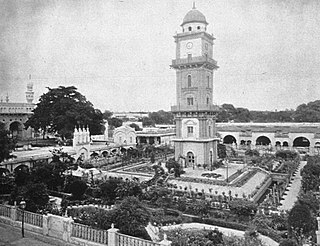
The Masjid-e-chowk, also known as Chowk Ke Masjid or Jama Masjid Chowk, is a mosque located in the Mahboob Chowk Clock Tower, Hyderabad, India. The mosque was constructed in 1817 by Khaja Abdullah Khan. The mosque was initially constructed with a three-arched facade. Later four arches were added by extending the structure and the two minarets in the front of rectangular hall.
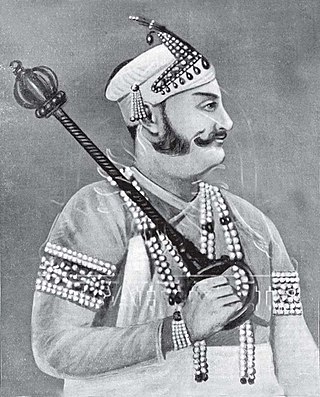
Shams ul-Umara, Shams ul-Mulk, Shams ud-Daula, Nawab Muhammad' Abu’l Fath Khan Bahadur, Taigh Jang Bahadur ['Abu’l Khair Khan II] [Imam JungIII] was an Indian nobleman and founder of the House of Paigah.


















